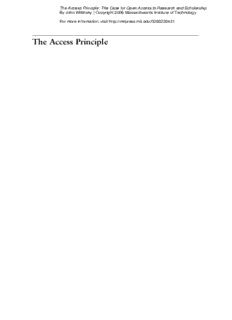
The Access Principle: The Case for Open Access to Research and PDF
Preview The Access Principle: The Case for Open Access to Research and
The Access Principle: The Case for Open Access to Research and Scholarship By John Willinsky | Copyright 2006 Massachusetts Institute of Technology For more information, visit http://mitpress.mit.edu/0262232421 The Access Principle Digital Libraries and Electronic Publishing William Y. Arms, series editor Gateways to Knowledge: The Roleof Academic Libraries inTeaching, Learning, and Research, edited by Lawrence Dowler, 1997 Civic Space/Cyberspace: The American PublicLibrary inthe Information Age,Redmond Kathleen Molz and Phyllis Dain, 1999 Digital Libraries,William Y. Arms, 1999 From Gutenberg to theGlobal Information Infrastructure:Accessto Information in the Networked World,Christine L.Borgman, 2000 The IntellectualFoundation of Information, Elaine Svenonius, 2000 Digital Library Use: Social Practice in Design and Evaluation,edited by Ann Peterson Bishop,NancyA. Van House, and BarbaraP. Buttenfield, 2003 TREC:Experiment and Evaluation in Information Retrieval, edited by Ellen M.Voorhees and Donna K. Harman,2005 The AccessPrinciple: The Case for Open Access toResearch and Scholarship,JohnWillinsky, 2005 The Access Principle The Case for Open Access to Research and Scholarship John Willinsky The MIT Press Cambridge, Massachusetts London,England (2006MassachusettsInstituteofTechnology Allrightsreserved.Nopartofthisbookmaybereproducedinanyformbyany electronic or mechanical means (including photocopying, recording, or informa- tionstorageandretrieval)withoutpermissioninwritingfromthepublisher. MITPressbooksmaybepurchasedatspecialquantitydiscountsforbusinessor sales promotional use. For information, please e-mail hspecial_sales@mitpress .mit.edui or write to Special Sales Department, The MIT Press, 55 Hayward Street,Cambridge,MA02142. ThisbookwassetinSabonon3B2byAscoTypesetters,HongKong,and printedandboundintheUnitedStatesofAmerica. LibraryofCongressCataloging-in-PublicationData Willinsky,John,1950– Theaccessprinciple:thecaseforopenaccesstoresearchandscholarship/John Willinsky. p. cm.—(Digitallibrariesandelectronicpublishing) Includesbibliographicalreferencesandindex. ISBN0-262-23242-1(hc:alk.paper) 1.Openaccesspublishing. 2.Scholarlyelectronicpublishing. 3.Science publishing. 4.Librariesandelectronicpublishing. 5.Communicationinlearning andscholarship. 6.Communicationinscience. I.Title. II.Series. Z286.O63W55 2006 070.50797—dc22 2005047471 10 9 8 7 6 5 4 3 2 1 ToJMH and ARH Contents Introduction ix Acknowledgments xvii 1 Opening 1 2 Access 13 3 Copyright 39 4 Associations 55 5 Economics 69 6 Cooperative 81 7 Development 93 8 Public 111 9 Politics 127 10 Rights 143 11 Reading 155 12 Indexing 173 13 History 189 Appendixes A Ten Flavors of Open Access 211 B ScholarlyAssociation Budgets 217 C Journal Management Economies 221 D AnOpen AccessCooperative 227 viii Contents E Indexingof the SerialLiterature 233 F Metadata for Journal Publishing 241 References 245 Index 271 Introduction By the dawn of the twenty-first century, the tidy but modest library that looks out on the gardens at the Kenya Medical Research Institute (KEMRI) in Nairobi was able to subscribe to only five medical jour- nals. As Nancy Kamau, the institute’s librarian, explained to me, since KEMRI had opened in 1979, it had been forced to cut one journal title after another from its list of subscriptions, as prices kept jumping ahead of the budget allocation and the Kenyan currency fluctuated. The real shame of it, Kamau pointed out, was that the final five subscriptions, which they could barely afford, did not include the leading journals on the institute’s principal research interest, tropical diseases. How could KEMRI properly support its current projects in biotechnology, leprosy, malaria,publichealth,andotherareaswithaninordinatelysmallsample of the relevant literature? Funding for these projects, which came from collaborationswithdevelopednations(rangingfromtheWellcomeTrust intheUnitedKingdomtotheWalterReedArmyInstituteofResearchin the United States) went into salaries, support for students, and keeping the institute running. And although the institute’s faculty found ways to gettheirhandsonaspecificarticle, whetherbyrequestingacopyfroma colleague they knew in the West or by picking it up when they had an opportunity to travel abroad, the leading medical research center in East Africa was itself operating more and more in a research literature vacuum. Then in July 2001 came a turning point. As Kamau went on to ex- plain, the World Health Organization managed to convince six of the leading corporate journal publishers to provide developing nations with open access to the electronic editions of their medical journals. This x Introduction meant that the online contents of a sizable number of medical journals were suddenly available at no charge to the faculty and students at KEMRI and elsewhere. The program, known as HINARI (the Health InterNetworkAccesstoResearchInitiative),hadgrownsincethentoen- compassover2,000journalsinthehealthfield,andithadnotbeenlong before the initiative had registered over 1,000 institutions from 101 of the world’s less fortunate countries. WhenIvisitedinJune2003,theKEMRIlibraryhadbutonecomputer foritspatronstousewiththeInternet,andtherewasasignupsheetona clipboardforfacultyandstudentstoplacetheirnamesontosecuresome time examining the wealth of literature newly available as a result of the initiative. A local university had recently sent over another six com- puters, whichwere still sittinginboxes,inan effort tohelp KEMRI take advantage of this boon to access the journals it needed. The sudden and radical turning point in the intellectual fortunes of KEMRI’s faculty and students spoke to how the Internet was being used in innovative ways to increase access to research. HINARI offered a particular model ofopenaccesstomedicalliterature,anditgreatlystrengthenedKEMRI’s ability to fulfill its promise as a research and training center. But the introduction of this open access approach to scholarly publishing is also having a public impact that extends well beyond the academic community. Underverydifferentcircumstances,theleadpieceintheNewYorker’s ‘‘Talk of the Town’’ for September 15, 2003, took issue with the educa- tional emphasis that the U.S. government was placing on student test scores,withthescoresservingastheentiremeasureofaschool’ssuccess or failure (Gladwell 2003, 34). In driving this critique home, the item’s author,staffwriterMalcolmGladwell,reached outtoastudybyRobert L. Linn (2003) that challenged the very reliability of the achievement tests the government was relying on. Linn’s study had been published two weeks earlier in Educational Policy Analysis Archives, an open ac- cess journal from Arizona State University. The journal had not issued a press release for Linn’s study, as medical journals do on occasion with breakthrough discoveries, nor had a research summary been issued. Gladwell found the study with Google, in all likelihood, and was able
Description: